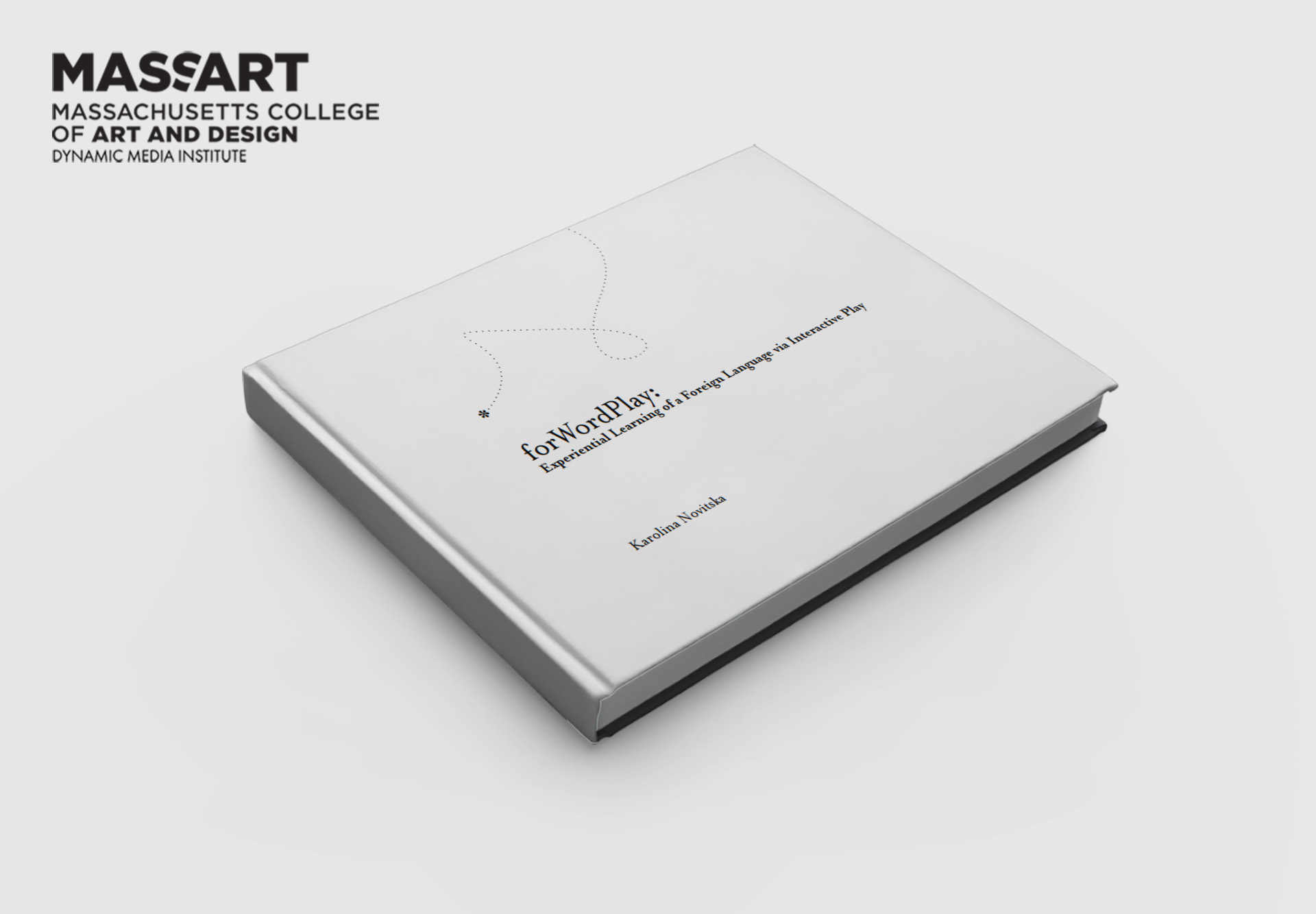Karolina Novitska, MFA ’06
thesis abstract
My thesis research investigates how play can influence learning a foreign language and how the interactive medium can serve as a bridge between the actions of learning and playing.
As children we learn our first language through a very natural, playful, and exploratory process in which all our surroundings serve as stimuli for this process. However, as adults, we typically learn a foreign language in a much more systematic and reflective manner, applying our existing life experiences to contextualize the new language.
While the latter method can be valuable at advanced levels of language development, when we are ready to build and reflect upon our basic understanding of a foreign language, the difficult task of learning the primary building blocks of a new language can be more rewarding from a child’s approach — learning through experimentation and play.
Playful, exploratory learning requires us to become active participants in the process rather than to passively receive information. Participatory learning can manifest itself in new media. Due to its modular, responsive and non-linear nature, new media allows content and curricula to be combined, remixed and customized in the most effective manner for each individual student. New media also allows infinite possibilities to surprise, engage minds, challenge perceptions, transcend time and geographic location, and to create a personal connection by appealing to our specific interests. I believe new media has a remarkable advantage to the analog world to provide an effective setting for these playful, exploratory learning experiences.
As a case study for my research, I have developed a range of prototypical modules for an interactive language learning system. My objective is to foster continuous exploration and stimulate participatory learning, while attempting to replicate the subconscious and relatively effortless learning we experience as children acquiring our first language.
Play for Learning: MetaLingua
Karolina’s thesis research included several prototypes of a language learning system, here, she discusses the final version, Metalingua.
Current language software assumes that the system should guide the learner where the software becomes an electronic teacher. My approach in MetaLingua emphasizes learning more so than teaching. What is it that makes an effective learning environment? Rieber defines it as a space where the resources, time, and reasons are available for students to nurture, support, and value their learning of a limited set of information and ideas (Rieber, 2001). MetaLingua is a model of experimentation, distributed control, and conversational exchange rather than a system guided by a sequential curriculum fully controlled by the teacher. Learning in MetaLingua is based on curiosity and interest as opposed to relying on specific rewards and threats. The learner shares control with the system, through dialogue rather than conquest — a dialogue that the learner initiates.
MetaLingua does not impose a prescriptive sequence of activities or topic. Rather, it responds to the learner’s interactions with specific, consistent, context-sensitive functionality. It allows the learner to initiate a dialogue and responds by generating unpredictable emerging effects and provides suggestions for further experimentation. MetaLingua is a learning environment that gives students autonomy, responsibility and flexible choices for their learning.
The constructivist principles are seamlessly woven into this iteration of my case study. By exploring linguistic content based on association and avoiding direct translation, the students construct their own knowledge, testing new hypothesis against real-world situations. By focusing on the experience of the user/character interaction, the system emphasizes process rather than product. By providing a nonlinear, user-driven access to a wide curriculum, it promotes student-directed, student-centered learning. Through multiple representation of linguistic content allowed by the digital medium, MetaLingua accommodates different learner styles and strategies.
MetaLingua also encourages users to try new learning styles by recognizing their interactive behavior, their successes, as well as the mistakes they make. If the learner is experiencing difficulty in understanding the material, the system introduces supplementary visual and audio clues as well as customizes the interactive behaviors to reflect a particular learning style.
One of the most important principles of learning in an interactive system is co-construction where learners feel like active agents (producers) and not just passive recipients of information (consumers). In a digital learning environment it is crucial for the student to feel that their actions and decisions are not just the designer’s actions and decisions. Rather, they should feel they are co-creating the world they are in and the experiences they are having. MetaLingua exemplifies this principle in a way that students feel empowered to reveal new information, to induce emotive and behavioral responses from the character, to experiment and play with the material interactively, and finally, to manipulate, affect and change the visual form of the environment. Thus, the experience of play becomes different for each student; learning becomes an active process of constant participation.
Deep learning in an interactive environment requires an extended commitment which is powerfully invoked when learners are able to take on a new identity. This allows them to become heavily invested in the experience. In MetaLingua, particularly reflected in the Train module — the learner takes upon the social role of a train passenger, participating in increasingly complex dialogues with the virtual human character. The character herself is so intriguing that she becomes a magnet for curiosity-driven continuous interaction that triggers deep investment in the learning experience.
In order for learning to occur, the challenges within the system should be pleasantly frustrating in a way that a learner feels at the outer edge of their competence. Thus, new challenges always seem difficult but approachable. MetaLingua adjusts the challenges and gives feedback via the visual and emotional responses which indicate whether or not the learner is on the path to success. Moreover, MetaLingua provides wellordered problems to learners; the initial challenges within the system seem relatively easy but are used to demonstrate the “rules of behavior” of the system in order for the learner to apply the same rules to harder problems in the future.
MetaLingua is a system of exploration, discovery and most importantly — play. It is an experimental approach designed to challenge traditional language teaching methods by utilizing playful interactivity for educational purposes. Perhaps this method is not meant to work for everybody. Those, however, who are willing to experiment with MetaLingua, might begin to view language learning with a child-like attitude and become more receptive to the new language. Willingness to experiment requires intriguing targets of experimentation. MetaLingua offers a multitude of uniquely responsive elements to interact with in order to reveal new information coupled with opportunities to affect, manipulate and change the unusual environment. Curiosity-driven interaction causes these alterations to the system which in turn promote student’s interest and willingness to continue the process of meaningful experimentation and play, which, as I have showed, results in learning.
Download “forWordPlay: Experiential Learning of a Foreign Language via Interactive Play” (PDF, 8 MB).











